UPDATED: APRIL 27, 2023 | 2 MIN READ
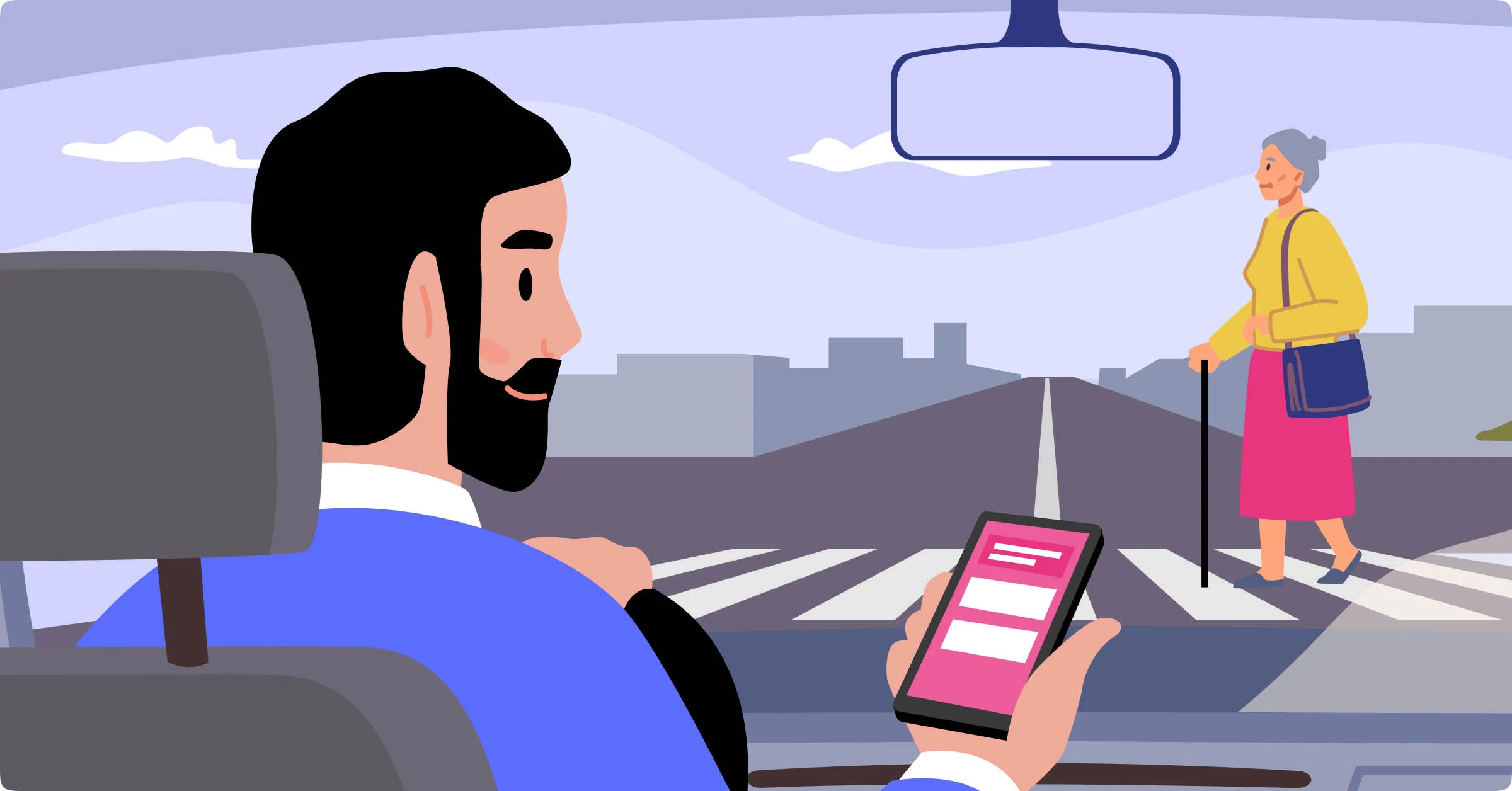
According to the World Health Organization (WHO), an estimated 1.35 million people die each year due to road traffic accidents, and distracted driving is one of the leading causes of these accidents. Texting and driving, in particular, has become a major safety concern on the roads, as it takes drivers’ eyes off the road and diverts their attention from driving. Learn more about recent texting and driving statistics and how they impact car insurance rates.
Texting and driving statistics
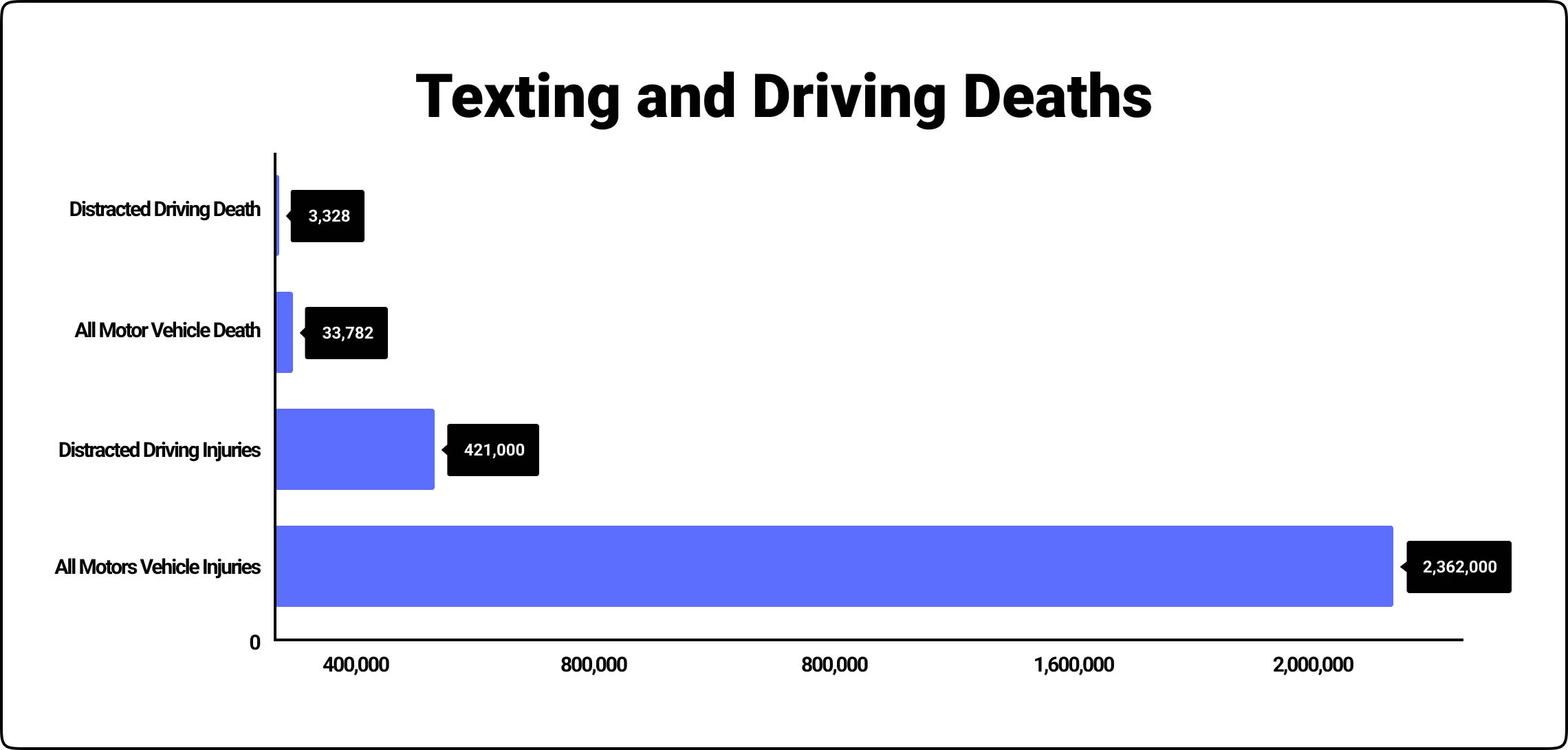
Did you know texting and driving claimed the lives of 3,522 lives in the U.S. in 2021?
While that might not seem extremely high compared to the country’s population, all these deaths could have been prevented.
Texting and driving deaths and injuries
Distracted driving, especially cell phone use, is a leading cause of fatal car crashes on the road. In fact, 14% of fatal crashes are caused by the use of cell phones. Furthermore, 14% of distracted driving deaths in driving accidents are attributed specifically to cell phone use, significantly contributing to distracted driving fatalities.
These alarming statistics highlight the importance of staying focused and attentive while driving and avoiding the use of cell phones or any other distractions that may cause fatal accidents.
The chart below depicts data gathered from the National Transportation and Safety Administration showing the amount of texting and driving injuries and deaths compared to the total amount of car-accident-related injuries and fatalities.
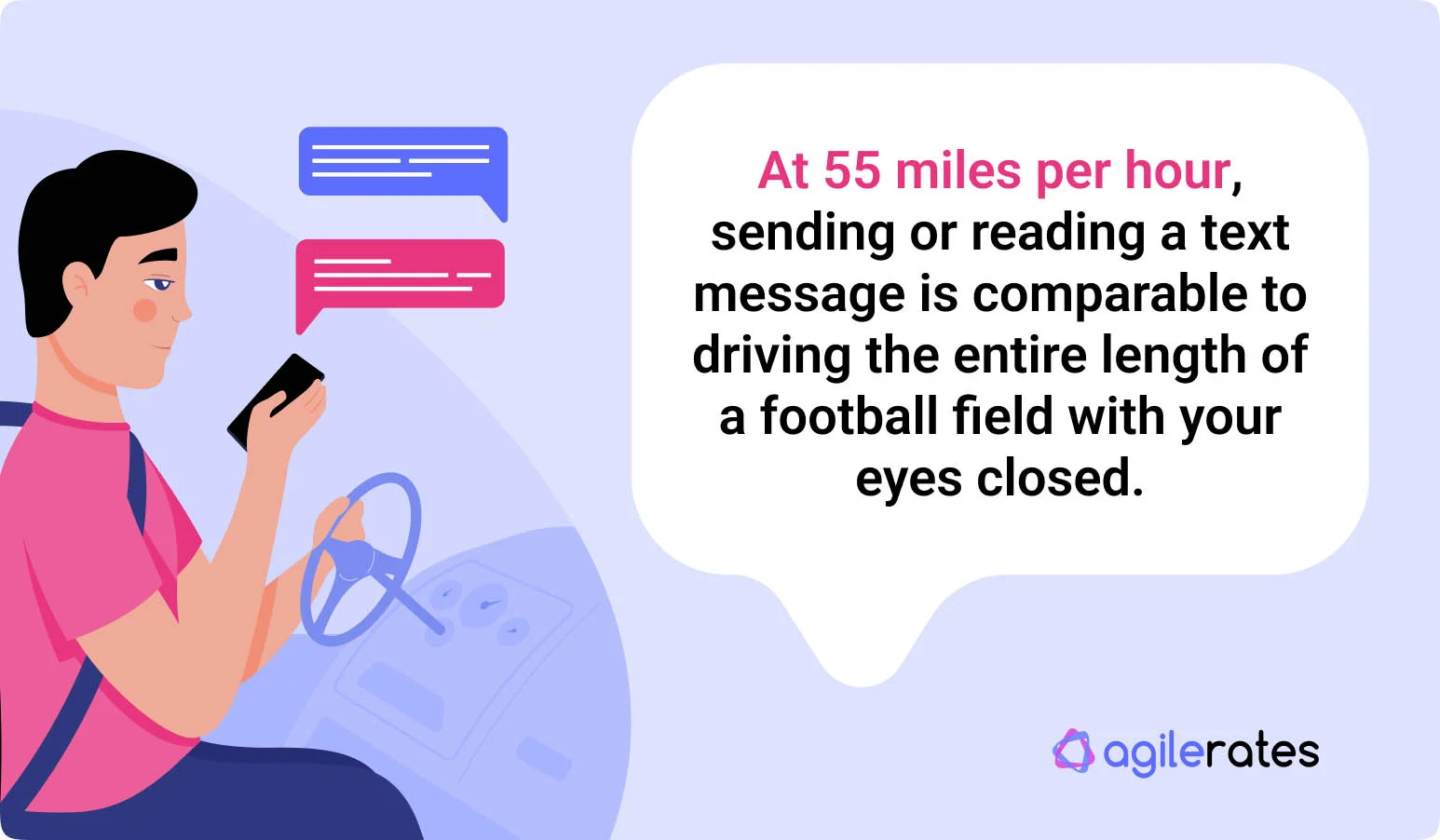
How does texting while driving affect your reaction time?
Your reaction times are slowed when you’re distracted while you drive. This increases the risk of an accident.
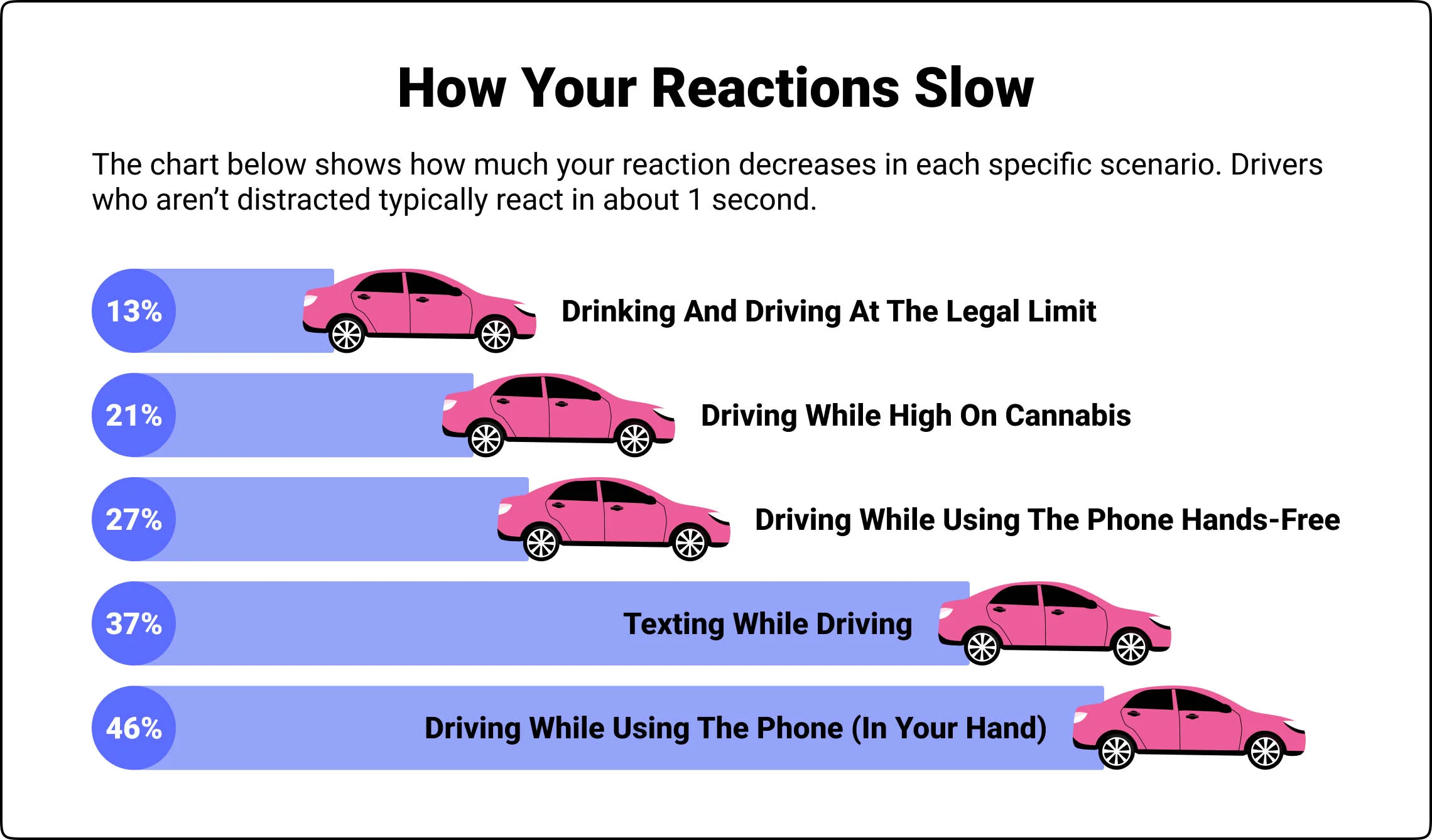
Here are some examples of how different scenarios, including cell phone use, affect your reaction times.
- Drinking and driving at the legal state limit slows your reaction time by 13%
- Driving while high on cannabis slows your reaction time by 21%
- Using your cell phone hands-free slows your reaction time by 27%
- Texting while driving slows your reaction time by 37%
- Talking on your phone (with it in your hand) slows your reaction time by 46%
Texting and driving laws by state
Many states have implemented laws to prohibit texting while driving to combat texting and driving. In fact, as of April 2023, 48 states currently have a texting ban in place, with only Arizona, Missouri, and Montana lacking such laws. Additionally, only 17 states have a ban on phone usage while driving and hands-free devices for all drivers.
These laws are important because, at any given time, 7% of drivers are using a cell phone. This includes texting, checking emails or social media, and making phone calls.
It’s important to know and understand the laws in your area because, in some states, you can be pulled over and cited for having your phone in your hand while driving. For example, as of April 2023, Ohio law allows distracted driving tickets to be issued to anyone who uses or holds a cell phone or electronic device while driving. According to the law, your phone can’t even be in your lap or anywhere on your body while operating a vehicle. You can, however, use hands-free options.
| State | Ban On Handheld Devices | All Cellphone Ban | Texting Ban |
|---|---|---|---|
| Alabama | No | School bus drivers and drivers under the age of 18 | All drivers |
| Alaska | No | No | All drivers |
| Arizona | Yes | School bus drivers, drivers with learner’s permits, drivers with provisional licenses for 6 months or less | All drivers |
| Arkansas | Drivers ages 18 through 20, drivers in school zones, and drivers in highway work zones | School bus drivers and drivers under age 18 | All drivers |
| California | Yes | School/transit bus drivers and drivers under the age 18 | All drivers |
| Colorado | No | Drivers under 18 | All drivers |
| Connecticut | Yes | School bus drivers, drivers with learner’s permits, and drivers under the age of 18 | All drivers |
| Delaware | Yes | Drivers with learner’s permits or intermediate licenses and school bus drivers | All drivers |
| Florida | No | No | All drivers |
| Georgia | Yes | School bus drivers and drivers under the age of 18 | All drivers |
| Hawaii | Yes | Drivers under 18 | All drivers |
| Idaho | No | No | All drivers |
| Illinois | Yes | School bus drivers, drivers with learner’s permits, and all drivers under 21 | All drivers |
| Indiana | No | Drivers under 21 | All drivers |
| Iowa | No | Drivers with learner’s permits or intermediate licenses | All drivers |
| Kansas | No | Drivers with learner’s permits or intermediate licenses | All drivers |
| Kentucky | No | School bus drivers and drivers under the age of 18 | All drivers |
| Lousiana | No | Drivers with learner’s permits or intermediate licenses, school bus drivers, and drivers under 18 | All drivers |
| Maine | Yes | Drivers with learner’s permits or intermediate licenses | All drivers |
| Maryland | Yes | Drivers with learner’s permits or drivers under 18 with intermediate licenses and school bus drivers | All drivers |
| Massachusetts | Depends on the city/county local law | School/passenger bus drivers and drivers under 18 | All drivers |
| Michigan | Depends on the city/county local law | Level 1 or 2 license holders | All drivers |
| Minnesota | Yes | Drivers with learner’s permits or who have had provisional driver’s licenses for less than 12 months and school bus drivers | All drivers |
| Mississippi | No | School bus drivers | All drivers |
| Missouri | No | No | Drivers age 21 or younger |
| Montana | No | No | No |
| Nebraska | No | Drivers with learner’s permits or intermediate licenses who are under 18 | All drivers |
| Nevada | Yes | No | All drivers |
| New Hampshire | Yes | Drivers under 18 | All drivers |
| New Jersey | Yes | Drivers with learner’s permits or intermediate licenses and school bus drivers | All drivers |
| New Mexico | Depends on the city/county local law | Drivers with learner’s permits or intermediate licenses | All drivers |
| New York | Yes | No | All drivers |
| North Carolina | No | School bus drivers and drivers under the age of 18 | All drivers |
| North Dakota | Virginia | Drivers under 18 | All drivers |
| Ohio | Depends on the city/county local law | Drivers under 18 | All drivers |
| Oklahoma | Drivers with learner’s permits, intermediate license holders, school and public bus drivers | School/transit bus drivers | All drivers |
| Oregon | Yes | Drivers under 18 | All drivers |
| Pennsylvania | Depends on the city/county local law | No | All drivers |
| Rhode Island | Yes | School bus drivers and drivers under the age of 18 | All drivers |
| South Carolina | No | No | All drivers |
| South Dakota | No | Drivers with learner’s permits or intermediate licenses | All drivers |
| Tennessee | Yes | Drivers with learner’s permits or intermediate licenses and school bus drivers | All drivers |
| Texas | Drivers in school zones | Drivers aged 16 and 17 who have had their intermediates licenses for less than 6 months | All drivers |
| Utah | Depends on the city/county local law | Drivers under 18 | All drivers |
| Vermont | Yes | Drivers age 16 and 17 who have had their intermediates licenses for less than 6 months | All drivers |
| Virginia | No | School bus drivers and drivers under the age of 18 | All drivers |
| Washington | Yes | Drivers with learner’s permits or intermediate licenses | All drivers |
| West Virginia | Yes | Drivers with learner’s permits or intermediate licenses who are under 18 | All drivers |
| Wisconsin | No | Drivers with learner’s permits or intermediate licenses | All drivers |
| Wyoming | No | No | All drivers |
| Washington D.C. | Yes | Drivers with learner’s permits and school bus drivers | All drivers |
Tips for preventing distracted driving
To prevent accidents and ensure the safety of all drivers and passengers, it is important to take steps to avoid distractions while driving. Here are some useful tips for preventing distracted driving to help drivers stay focused on the road, minimize phone usage, and utilize technological and personal solutions to prevent distracted driving.
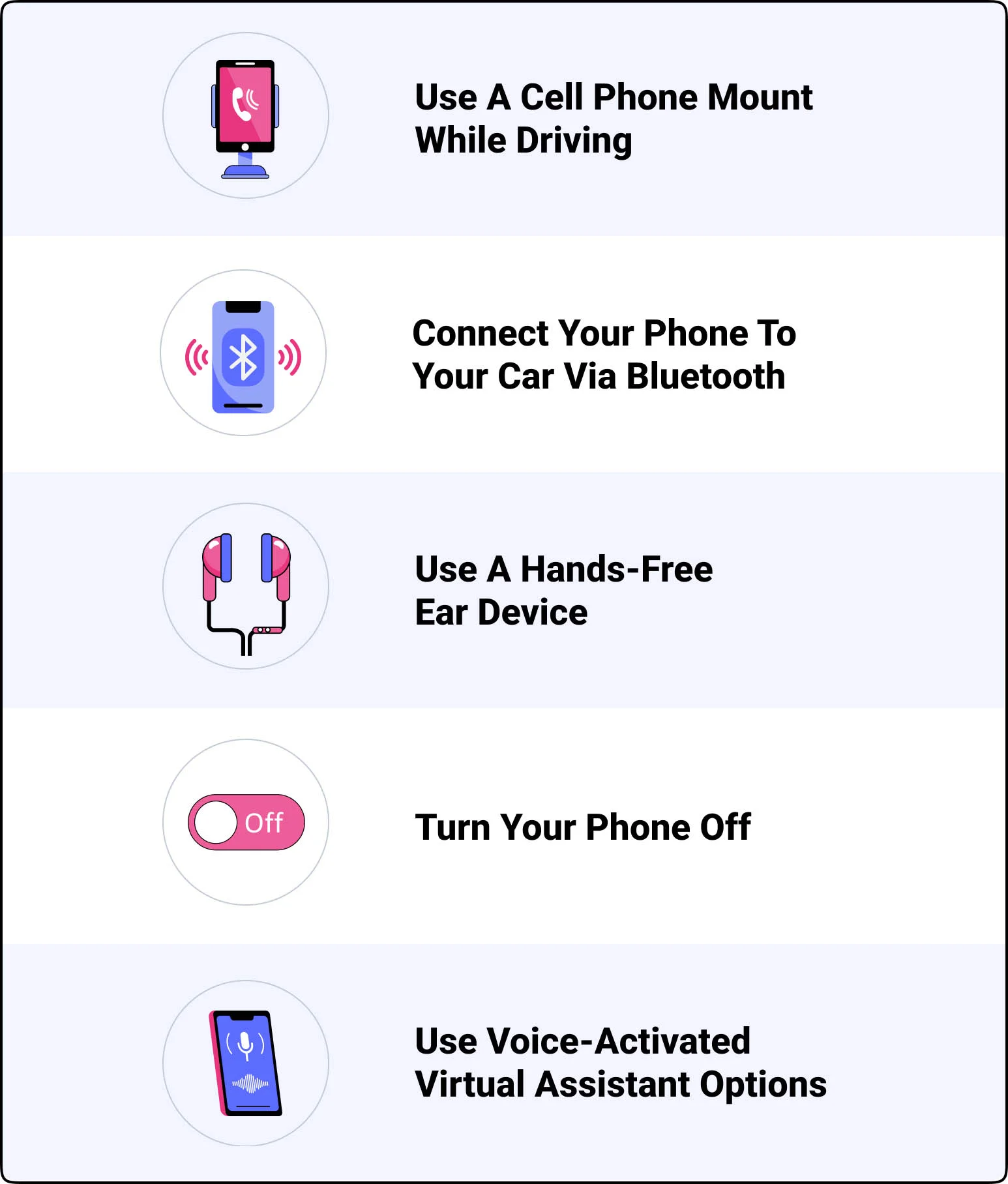
Use a cell phone mount while driving
Cell phone mounts attach to your car’s dashboard or hook onto the vent so you can easily access your phone while driving. This doesn’t mean you should be texting or emailing while you’re driving, though.
Ideally, you should use a cell phone mount if you need to use your GPS and need to see the phone’s screen to do so. You should still connect your phone to your car via Bluetooth if possible. This way, you can hear the directions and only glance at your phone as needed.
Connect your phone to your car via Bluetooth
To listen to music, audiobooks, or podcasts and take calls hands-free, connect your phone to your car via Bluetooth. This connects your phone to your car speakers, making it easier to listen while driving.
Use a hands-free ear device
If you have an older vehicle without Bluetooth or AUX connection, consider purchasing a hands-free ear device for your phone. This way, you can still take a call while driving if you need to.
Turn your phone off
If you don’t need to use your phone’s GPS and don’t rely on it to listen to music, podcasts, or audiobooks, consider turning your phone off while you drive. Alternatively, you can put your phone in Airplane mode, which disconnects your phone’s data, WiFi, and Bluetooth capabilities.
Use voice-activated virtual assistant options
Instead of sending or reading text messages while driving, use your phone’s voice-activated virtual assistant option. Both Siri and Google Assistant have voice-to-text capabilities.
How does a ticket for distracted driving affect your car insurance rates?
If you get a distracted driving ticket, it’s likely to increase your car insurance rates when your policy renews. On average, rates increase by about 21% after one violation. However, the amount of the increase depends on your insurance carrier and state. Some people may see upwards of a 46% premium increase.
FAQs
What are the dangers of texting and driving?
Texting and driving is a dangerous behavior that diverts a driver’s attention from the road and increases the risk of a motor vehicle accident. Some of the dangers of texting and driving include:
- Reduced reaction time
- Impaired driving
- Increased risk of accidents
- Legal penalties
Is texting and driving illegal?
Texting while driving is illegal in most states. However, the specific laws and penalties for texting and driving vary depending on the jurisdiction, but in general, it is considered a form of distracted driving and can result in legal consequences if caught.
How many people die from texting while driving?
In 2020, NHTSA data revealed that 396 people were killed due to accidents caused by texting and driving. This statistic means there was more than one death per day due to texting while driving.
Can you legally use your cell phone while driving in the USA?
As of April 2023, 48 states, Washington D.C., Puerto Rico, Guam, and the U.S. Virgin Islands have laws banning drivers from texting while driving. However, only 25 states, Washington D.C., Guam, Puerto Rico, and the U.S. Virgin Islands ban drivers from handheld cell phone use.
How to protect yourself from people texting and driving
If you’re concerned about the dangers of texting and driving on the roads, you can do a few things to protect yourself.
First, make sure to always wear your seatbelt and follow all traffic laws. Additionally, consider investing in safety features for your car, such as blind spot monitoring or automatic emergency braking. Finally, make sure your car insurance includes uninsured/underinsured motorist coverage to protect you from distracted drivers without insurance.
To ensure you have the best coverage at the most competitive price, compare car insurance quotes from multiple providers today.
Sources:
- “Global Status Report On Road Safety 2019 (World Health Organization)
- “Distracted Driving Dangers” (National Highway Transportation and Safety Administration)
- “Transportation Safety, Distracted Driving” (Centers for Disease Control and Prevention)
- Texting and Driving Statistics (The Zebra)
- State Laws on Distracted Driving – Ban on Hand-Held Devices and Texting While Driving (Bureau of Transportation Statistics)
Related content: